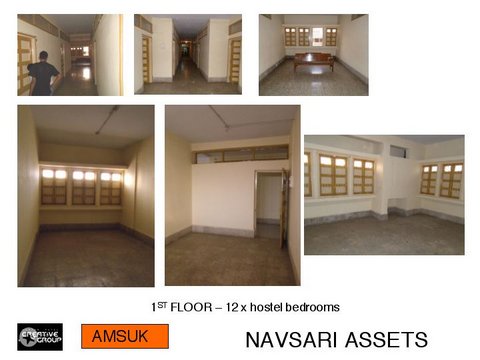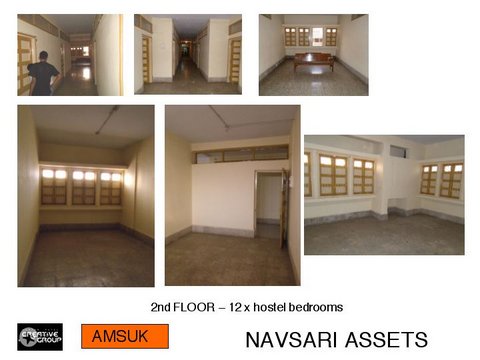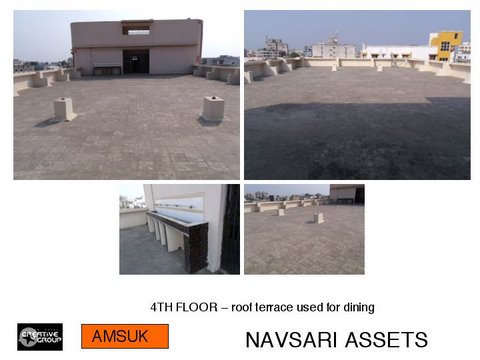Koli Patel Samaj Properties in Navsari
The present day Navsari District was a part of Valsad District and before then both of them were part of Surat District.
The city of Navsari is the commercial hub of the District serving hundreds of surrounding villages. A large majority of our Koli Patel Samaj people live in the villages and look to the city for employment, shopping, medical services, higher education for their children and various other needs.
Some of the primary services are now available in almost all the villages but in the olden days one was fully dependent on the city, as they still have to do for any specialist services required.
Well over a hundred years ago our Koli people’s main occupation was agriculture and animal husbandry, hence Koli Patel. These occupations were very limited so our youths of the time, even though uneducated started going far a field looking for employment. When South Africa was opened up for immigration a number of our people went there and in due course settled there. Here we are talking about the year 1883 onwards.
Although these early immigrants were uneducated they were not ignorant. They soon realized that education was holding our people back. So having set up Transvaal Koli Hitwarthak Mandal in South Africa, these visionaries started thinking about ways to help their brethrens in the villages of Navsari.
The first property they bought, housed village students who were then able to study in Navsari. Later they bought three other properties.
Koli Patels of Navsari District as a community owns 4 properties in Navsari. All these properties were purchased by our forefathers who migrated to South Africa and in the 1st and 2nd quarters of 20th century. Their intention was to help the Koli Patel community of Navsari District (Surat District) at the time, to develop these properties for educational and cultural purposes so that the community may raise its living standard and raise its social status.
The 4 Properties are:
| Koli Patel Ashram | Nutan Society Land | Chhapra Road Land | TKHM(SA)Navsari |
| Site 4 on map | Site 3 on map | Site 2 on map | Site 1 on map |
| Purchased: 1926 | Purchased: 1947 | Purchased: 1947 | Purchased: 1962 |
| Rebuilt: 1973 mainly with UK/Overseasdonations | 44084 sq. ft flat land.Undeveloped | 2.20 acres of Mango plantation | 3.81 Acres Undeveloped. Bunglow delapidated |
| MANAGEMENT: | |||
| Trusts Involved:(a) N.V.K.T. | (a) N.V.K.T. | Trust Involved:(b) D.G.K.K.M. | Trust Involved;(c ) TKHM (SA) |
| Mohanbhai Vakil | Mohanbhai VakilNavsari Nagarpalika has put this site on their 10 year development plan | Disputed byAmrutbhai Koli,Claiming it for DGKKM with
N.V.K.T.
|
Thakorebhai Vallabhbhai Patel
|
| TITLE DEEDS: | |||
| N.V.K.T. | N.V.K.T. | Kuverji Gopalji | TKHM (SA) |
N.V.K.T. – Navsari Vibhag Keravani Trust
D.G.K.K.M. – Daxin Gujarat Koli Keravani Mandal
T.K.H.M. (S.A.) – Transvaal Koli Hitwarthak Mandal (South Africa).
These properties are marked on the map below:
These Navsari Assets came into our focus when we learnt that Transvaal Koli Hiywarthak Mandal of South Africa was planning to sell the Transvaal Koli Hitwardhak Mandal land in Navsari (the piece of 4 acre land and building on the land) and repatriate the proceed to South Africa.
I was most vocal in opposing the idea on the principle that no donor (let alone the descendents of the original donors) had the right to ask for the donation to be returned once the donation had been put to use by the receiving organization.
I with a few others organized opposition groups in India, NZ, South Africa, USA etc. I was almost on a weekly contact with SA and with guidance from here and elsewhere a new Management Committee which was opposed to selling was elected and the idea to sell the property in Navsari was dropped.
It was then that we learnt that there were more than the two properties that were originally purchased by our forefathers from SA and given to Koli Patel Samaj of Navsari District (Surat District at the time), with a view to raise their educational standard and the status of the community as a result. (See table above).
Shree Bhikhubhai L Patel of Preston, UK was in India and I asked him to investigate and bring back as much detail as possible. The information he came back with opened our eyes to the tremendous possibilities. The four properties valued at around Rs. 20-30 crores was at stake.
When you consider that our Koli Patel forms almost 40% of the population of Navsari District and we have absolutely no say in the decision making in running the District something can be done. It is also a shame that a community that owns Rs. 30 crores of property and earn a paltry 3 lakh rupees income just 1/10th of a percentage.
Further information on the properties brought out the skeletons from the cupboard. We learnt of a number of individuals and organization staking claim on the properties and worse of all some individuals behaved as though they owned the property.
After a detailed report in a years time Association of Mandhata Samaj, UK decided to initiate a project to development the Navsari Assets – Navsari Assets Project.
Over the last three years several AMSUK Committee members, other representatives from USA, New Zealand, South Africa, etc, and others interested individuals visited Navsari, held two public meetings and a number of discussions with local teams with a view to agree a program of works suitable for the Community’s present day needs.
Some agreement have been possible but the substantial progress needed to start on the ground has eluded us so far.
It appears that while we are all agreed as to the need for development, the various parties involved has not yet built full trust among one another. May be new teams and new ideas and certainly new teams in Navsari are required to make progress.
After two years of our involvement the meeting of minds as to the way ahead is still wide apart.
Why should we develop these properties?
Koli Patels form some 40% of the population of Navsari District yet have very little, almost negligible influence in the running of Navsari. Most live in the villages and are mainly poor, unskilled and semi-employed.
They have low social status among the other communities. The fact that the owenership of 30 crores worth properties can only generate just 0.1 % of income shows how financially naive we are, even in this day and age.
The 4 properties are very valuable and may fetch over 30 Crore Rupees. But have a mere 3 lakh Rupees revenue per year via rent income of Koli Patel Samaj Ashram.
As far as I am concerned the only reason we want to develop these properties is to help our people in Navsari villages to fast tract them into higher education and technical skill to get them ready for better paid jobs, etc.
There are many other reasons and needs but this to me is crucial as standing on their own two feet is of first importance to give the local people the confidence they need to undertake the development of the Samaj locally.
If we have any other agenda we had better think twice before going in. None of us, those who wish to devote time and effort to the project’s success or our donors must accept the fact that any personal benefit would accrue to them. It is compassion pure and simple. The way our forefathers from South Africa had in mind.
This is a also a project that no one organization can own it. Certainly not an organization based overseas like AMSUK or any other even if it acts as an initiator and provides a lions share of the development costs and all the expertise required. AMSUK or any other organization if they decide to get involved, it will have to work on the basis that it has a moral responsibility to raise the standard and status of our people in Navsari, it should refrain from any ownership claims or management involvement after the job has been done, except in an advisory role. The undeveloped land and property belongs to Navsari and these have to be developed for their benefit. For the first time this is a propject that would give us an opportunity to work on an international scale that would bring our whole global community together.
The best way to proceed with this project is to appoint a say ten member project team of experienced and committed individuals from various countries who can spare the time. The role of the initiator would be to agree a phase of work to be done, provide the finances, and let the team get on with the job without interferences.
What is involved.
Lots of goodwill. Lots of hard work. Lots of frustration. Lots of convincing both in Navsari and overseas. Lots of tension. Lots of understanding. Lots of give and take.
None of the above Trusts in Navsari have credible constitutions or forward looking management. The Trustees see themselves as lifetime trustees and act as though the properties belong to them.
To start with:
The Title Deeds have to be sorted out.
Local Trusts have to be brought up to date in terms of Constitution, Management, Accountability.
Assessing needs. This would be easy if we confine ourselves to just one task at a time – say technical education. (Building, Equipment, Management, Running cost, etc).
Planning.
Developing all 4 sites would be a multi dimensional project. This can be broken down in smaller units and then the task becomes easy. Each small unit can be individually costed, built and run.
Each unit however must be part of an overall plan, which initially can be in outline only so that no building is put where it may not belong.
Overall financial targets can be assessed and set. To be realistic however it must be within achievable limits for it to be credible and would only be possible when a large amount of donations were available. A number of the projects will have to be undertaken with a view purely to generate revenue for the continuous running of community activities.
Of the 4 sites one is fully developed although not fully utilized. This has to be seriously looked into. Making this unused facilities productive would generate several lakhs every year. An assessment has to be made to confirm if all the remaining sites are needed or to be developed. If it is considered that one or two of the sites are surplus to requirements then consideration must be given to realize this investment to pay for other necessary developments.
The whole local and international Samaj need to take active interest in this development. All actively interested and involved must work urgently as a committed team for the welfare of the Navsari Koli Patel Samaj. If nothing else, to secure the properties for the local Samaj for later generations to work on.
Other interested parties have an eye on our highly desirable properties. If we are not careful we may be done for.
Keshavlal J Patel.




















































